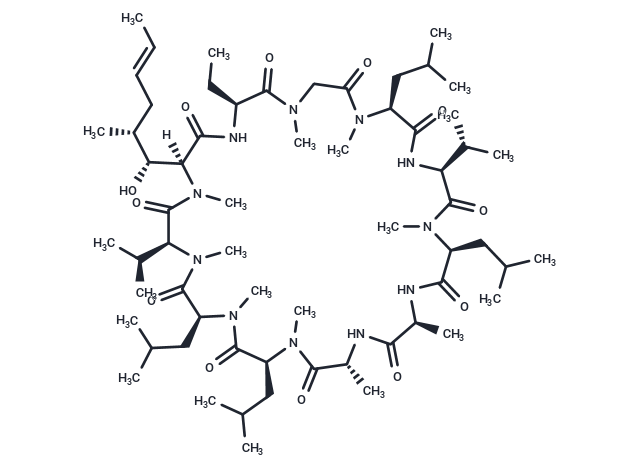Shopping Cart
- Remove All
 Your shopping cart is currently empty
Your shopping cart is currently empty

Cyclosporin A is a naturally occurring cyclic polypeptide that is the active metabolite of a fungus. Cyclosporin A is an immunosuppressant that binds to procyclins and inhibits calcineurin (IC50=7 nM).

| Pack Size | Price | Availability | Quantity |
|---|---|---|---|
| 50 mg | $36 | In Stock | |
| 100 mg | $50 | In Stock | |
| 200 mg | $66 | In Stock | |
| 1 mL x 10 mM (in DMSO) | $50 | In Stock |
| Description | Cyclosporin A is a naturally occurring cyclic polypeptide that is the active metabolite of a fungus. Cyclosporin A is an immunosuppressant that binds to procyclins and inhibits calcineurin (IC50=7 nM). |
| Targets&IC50 | Calcineurin phosphatase:7 nM |
| In vitro | METHODS: Glioma cell C6 was treated with Cyclosporin A (10 μM) under hypoxic conditions for 4 h. The expression levels of target proteins were measured by Western Blot. RESULTS: 4 h hypoxia induced a large accumulation of endogenous HIF-1α protein, and Cyclosporin A prevented most of the hypoxia-induced HIF-1α stabilization. [1] METHODS: Human colon cancer cells CACO-2 were treated with Cyclosporin A (2 μM) for 24-72 h. The cell cycle was detected by Flow Cytometry. RESULTS: Accumulation of cells was detected in the G0/G1 phase after treatment with Cyclosporin A. The RESULTS were summarized in the following table. [2] |
| In vivo | METHODS: To assay activity against muscle disease in vivo, Cyclosporin A (5 mg/kg in olive oil) was injected intraperitoneally into myopathic Col6a1-/- mice twice daily for ten days. RESULTS: Cyclosporin A affected satellite cell activity and triggered regenerative fiber formation in Col6a1-/- mice. [3] METHODS: To detect the effects on ischemia-reperfusion injury (IRI), Cyclosporin A (3 mg/kg, 1 h or 10 min before ischemia; 10 mg/kg, 10 min before ischemia) was intraperitoneally injected into ischemia-reperfused C57BL/6J mice. RESULTS: Mortality and renal function were significantly higher in the Cyclosporin A 10 mg/kg-10 min and Cyclosporin A 3 mg/kg-1 h groups than in the Cyclosporin A 3 mg/kg-10 min group. [4] |
| Kinase Assay | Phosphatase Assay: Purified bovine brain calcineurin and calmodulin are purchased. Reaction mixtures with purified enzyme contains 100 nM calcineurin, 100 nM calmodulin, and 5 μM 32P-labeled phosphopeptide, in 60 μl (total volume) of assay buffer containing 20 mM Tris (pH 8), 100 mM NaCI, 6 mM MgCl2, 0.5 mM dithiothreitol, 0.1 mg of bovine serum albumin per ml, and either 0.1 mM CaCl2 or 5 mM EGTA. Reaction mixtures with cell lysates contains 20 μl of undiluted lysate, 5 μM 32P-labeled phosphopeptide, and 40 μl of assay buffer. Where indicated, reaction mixtures contains 50 μM peptide 412 or 413 and/or 500 nM okadaic acid, a specific inhibitor of phosphatases 1 and 2A; 500 nM okadaic acid is sufficient for inhibition of Ca2+-independent phosphatases, whereas higher concentrations partially inhibit Ca2+-dependent activity as well. After 15 min at 30°C, reactions are terminated by the addition of 0.5 ml of 100 mM potassium phosphate buffer (pH 7.0) containing 5% trichloroacetic acid. Free inorganic phosphate is isolated by Dowex cation-exchange chromatography and quantitated by scintillation counting as described. |
| Cell Research | Immunosuppressive agents are dissolved in ethanol at concentrations 1000-fold more than the concentration desired for cell treatments. Cells (106) are suspended in 1 ml of complete medium in microcentrifuge tubes; 1 μl of ethanol or of the ethanolic solution of Cyclosporin A is added, and the cells are incubated at 37°C for 1 hr. Cells are washed twice with 1 ml of PBS on ice and lysed in 50μl of hypotonic buffer containing 50 mM Tris (pH 7.5); 0.1 mM EGTA; 1 mM EDTA; 0.5 mM dithiothreitol; and 50 μg of phenylmethylsulfonyl fluoride, 50 μg of soybean trypsin inhibitor, 5 μg of leupeptin, and 5 μg of aprotinin per ml. Lysates are subjected to three cycles of freezing in liquid nitrogen followed by thawing at 30°C and then are centrifuged at 4°C for 10 min at 12,000×g.(Only for Reference) |
| Alias | Cyclosporine A, Cyclosporine, Ciclosporin |
| Molecular Weight | 1202.61 |
| Formula | C62H111N11O12 |
| Cas No. | 59865-13-3 |
| Smiles | [C@H]([C@@H](C/C=C/C)C)(O)[C@@]1(N(C)C(=O)[C@H]([C@@H](C)C)N(C)C(=O)[C@H](CC(C)C)N(C)C(=O)[C@H](CC(C)C)N(C)C(=O)[C@@H](C)NC(=O)[C@H](C)NC(=O)[C@H](CC(C)C)N(C)C(=O)[C@H]([C@H](C)C)NC(=O)[C@H](CC(C)C)N(C)C(=O)CN(C)C(=O)[C@H](CC)NC1=O)[H] |
| Relative Density. | 0.9913 g/cm3 (Estimated) |
| Storage | keep away from moisture | Powder: -20°C for 3 years | In solvent: -80°C for 1 year | Shipping with blue ice. | ||||||||||
| Solubility Information | DMSO: 60 mg/mL (49.89 mM), Sonication is recommended. Ethanol: 60.1 mg/mL (49.97 mM), Sonication is recommended. 10% DMSO+40% PEG300+5% Tween 80+45% Saline: 12.03 mg/mL (10 mM), suspension.In vivo: Please add the solvents sequentially, clarifying the solution as much as possible before adding the next one. Dissolve by heating and/or sonication if necessary. Working solution is recommended to be prepared and used immediately. | ||||||||||
Solution Preparation Table | |||||||||||
DMSO/Ethanol
| |||||||||||

Copyright © 2015-2025 TargetMol Chemicals Inc. All Rights Reserved.